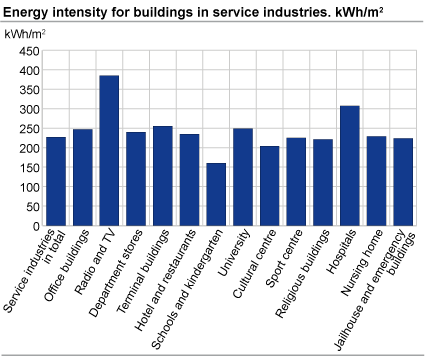Content
Published:
This is an archived release.
Large variation in energy use
In 2008, average purchased energy use in 5 000 industrial buildings within service industries was 227 kWh/m2. The largest energy source was electricity, which accounted for 82.3 per cent of total energy use. Total heated area in buildings within service industries was 22.5 million m2.
The statistics show large variations in energy use per square metre between and within different building types. This can be explained by differences in building constructions, area of application, the amount of electrical equipment and the scope of implemented energy efficiency measures. Specific energy use varied from above 1000 kWh/m2 to under 100 kWh/m2. Buildings with high energy use had extremely energy intensive equipment, while those with substantial low energy use had limited technical equipment and a short period of use. Hospitals, radio and television production companies are among those building types with highest energy use. These buildings have substantial energy intensive equipment, high levels of activity and period of use. Schoolhouses and kindergartens are among those building types with the lowest energy use per square metre. Many of these building are only used during the day and the fact that many people stay in limited areas leads to a lower need for heated areas.
District heating the second largest energy source
Electricity is the largest used energy source in most building types, but for some buildings district heating accounts for a substantial share of total energy use. Among those building types that use a high share of district heating are universities, colleges and sports centres. The share of district heating accounted for 11.5 per cent of total energy use in buildings. Heating oil is also used in some buildings, but accounted only for 2.8 per cent of total energy use. Other energy sources, such as pellets and gas were important energy sources for some large buildings. However, in total these energy sources accounted for only a minor share of total energy use. Results also show that wood is little used in industrial buildings.
Central heating an important heating source
Half of the buildings in the sample had central heating as their main heating source, while 15 per cent used district heating and 10 per cent had heating pumps. Panel oven was the most common heating equipment in industrial buildings, but some buildings had electrical floor heating, wood ovens or other equipment for local heating. Many had these types of heating equipment in addition to central heating, district heating and heating pumps.
Tables:
Contact
-
Statistics Norway's Information Centre
E-mail: informasjon@ssb.no
tel.: (+47) 21 09 46 42

